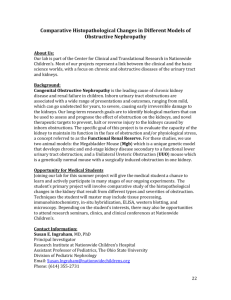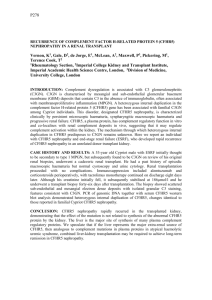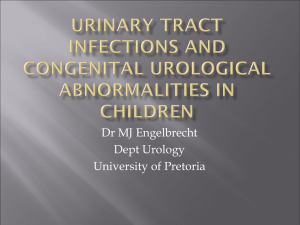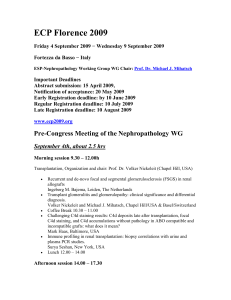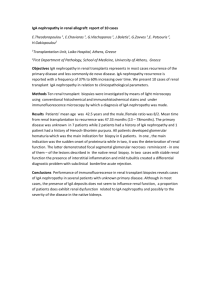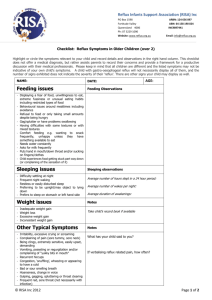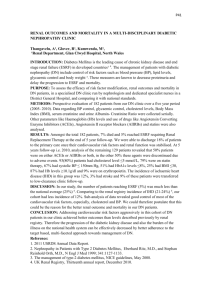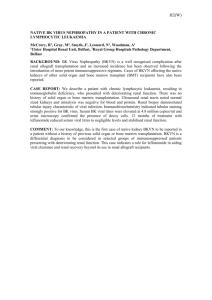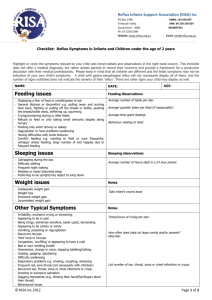31/2011 - Repatriation Medical Authority
advertisement
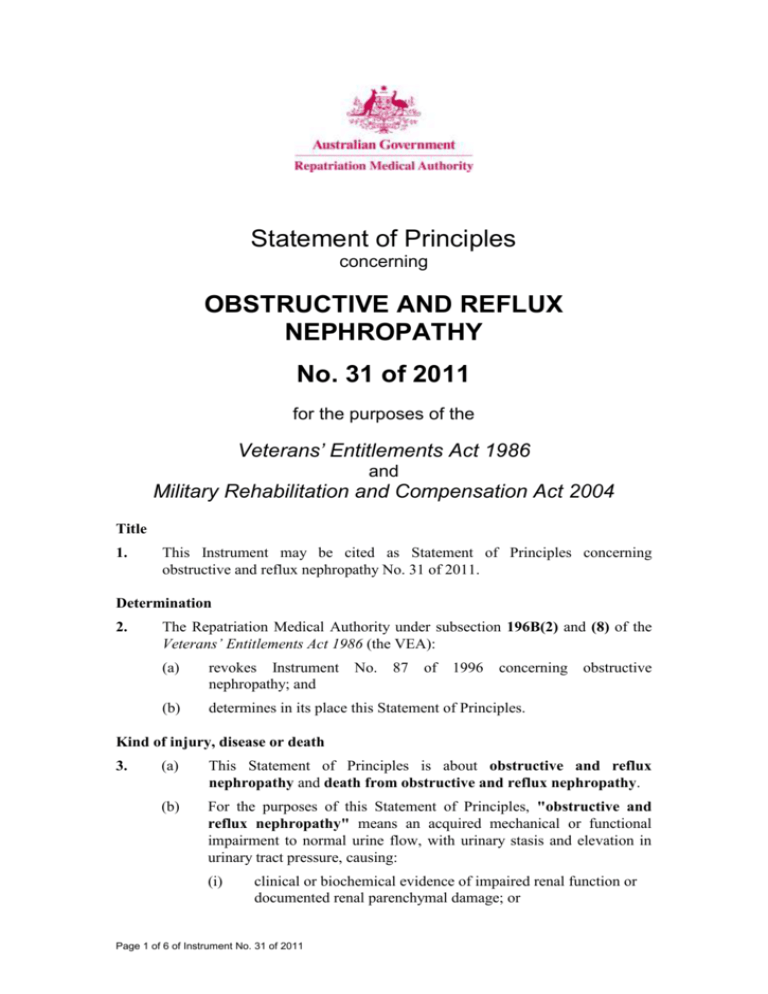
Statement of Principles concerning OBSTRUCTIVE AND REFLUX NEPHROPATHY No. 31 of 2011 for the purposes of the Veterans’ Entitlements Act 1986 and Military Rehabilitation and Compensation Act 2004 Title 1. This Instrument may be cited as Statement of Principles concerning obstructive and reflux nephropathy No. 31 of 2011. Determination 2. The Repatriation Medical Authority under subsection 196B(2) and (8) of the Veterans’ Entitlements Act 1986 (the VEA): (a) revokes Instrument nephropathy; and No. 87 of 1996 concerning obstructive (b) determines in its place this Statement of Principles. Kind of injury, disease or death 3. (a) This Statement of Principles is about obstructive and reflux nephropathy and death from obstructive and reflux nephropathy. (b) For the purposes of this Statement of Principles, "obstructive and reflux nephropathy" means an acquired mechanical or functional impairment to normal urine flow, with urinary stasis and elevation in urinary tract pressure, causing: (i) clinical or biochemical evidence of impaired renal function or documented renal parenchymal damage; or Page 1 of 6 of Instrument No. 31 of 2011 (ii) calyceal deformity and dilatation of the ureter (hydroureter) or renal pyelocalyceal system (hydronephrosis). This definition includes reflux nephropathy and hydroureter occurring in the absence of mechanical obstruction of the urinary tract. This definition excludes physiological hydroureteronephrosis of pregnancy, and congenital reflux or obstructive defects of the renal pelvis and ureter. (c) Obstructive and reflux nephropathy attracts ICD-10-AM code N13. (d) In the application of this Statement of Principles, the definition of "obstructive and reflux nephropathy" is that given at paragraph 3(b) above. Basis for determining the factors 4. The Repatriation Medical Authority is of the view that there is sound medicalscientific evidence that indicates that obstructive and reflux nephropathy and death from obstructive and reflux nephropathy can be related to relevant service rendered by veterans, members of Peacekeeping Forces, or members of the Forces under the VEA, or members under the Military Rehabilitation and Compensation Act 2004 (the MRCA). Factors that must be related to service 5. Subject to clause 7, at least one of the factors set out in clause 6 must be related to the relevant service rendered by the person. Factors 6. The factor that must as a minimum exist before it can be said that a reasonable hypothesis has been raised connecting obstructive and reflux nephropathy or death from obstructive and reflux nephropathy with the circumstances of a person’s relevant service is: (a) having obstruction of the ureter or renal calyx on the affected side before the clinical onset of obstructive and reflux nephropathy; or (b) having obstruction of the bladder outlet or urethra before the clinical onset of obstructive and reflux nephropathy; or (c) having a renal or ureteric transplant within the six months before the clinical onset of obstructive and reflux nephropathy; or (d) having functional obstruction of the ureter or renal calyx within the four weeks before the clinical onset of obstructive and reflux nephropathy; or (e) being treated with a drug from a class of drugs in the specified list, where treatment with the drug continued for at least the seven days before the clinical onset of obstructive and reflux nephropathy; or Page 2 of 6 of Instrument No. 31 of 2011 (f) having obstruction of the ureter or renal calyx on the affected side before the clinical worsening of obstructive and reflux nephropathy; or (g) having obstruction of the bladder outlet or urethra before the clinical worsening of obstructive and reflux nephropathy; or (h) having a renal or ureteric transplant within the six months before the clinical worsening of obstructive and reflux nephropathy; or (i) having functional obstruction of the ureter or renal calyx within the four weeks before the clinical worsening of obstructive and reflux nephropathy; or (j) being treated with a drug from a class of drugs in the specified list, where treatment with the drug continued for at least the seven days before the clinical worsening of obstructive and reflux nephropathy; or (k) inability to obtain appropriate clinical management for obstructive and reflux nephropathy. Factors that apply only to material contribution or aggravation 7. Paragraphs 6(f) to 6(k) apply only to material contribution to, or aggravation of, obstructive and reflux nephropathy where the person’s obstructive and reflux nephropathy was suffered or contracted before or during (but not arising out of) the person’s relevant service. Inclusion of Statements of Principles 8. In this Statement of Principles if a relevant factor applies and that factor includes an injury or disease in respect of which there is a Statement of Principles then the factors in that last mentioned Statement of Principles apply in accordance with the terms of that Statement of Principles as in force from time to time. Other definitions 9. For the purposes of this Statement of Principles: "a drug from a class of drugs in the specified list" means: (a) (b) (c) (d) (e) alpha-adrenergic antagonists; anticholinergic drugs; antiemetic phenothiazines; opiates; or tricyclic antidepressants; "death from obstructive and reflux nephropathy" in relation to a person includes death from a terminal event or condition that was contributed to by the person’s obstructive and reflux nephropathy; Page 3 of 6 of Instrument No. 31 of 2011 "functional obstruction of the ureter or renal calyx" means interruption to urine flow that is not associated with fixed occlusion of the urinary drainage system. This definition includes obstruction from: (a) (b) (c) (d) (e) diabetic autonomic neuropathy; intravesical instillation of bacillus Calmette-Guérin; nephrogenic diabetes insipidus; neurogenic bladder dysfunction; or spinal cord injury (paraplegia or quadriplegia); "ICD-10-AM code" means a number assigned to a particular kind of injury or disease in The International Statistical Classification of Diseases and Related Health Problems, 10th Revision, Australian Modification (ICD-10-AM), Seventh Edition, effective date of 1 July 2010, copyrighted by the National Centre for Classification in Health, Sydney, NSW, and having ISBN 978 1 74210 154 5; "obstruction of the bladder outlet or urethra" means a blockage to the flow of urine due to an endogenous or exogenous pathological structure or extraneous material that compresses, displaces or infiltrates the bladder outlet or urethra. This definition includes obstruction from: (a) (b) (c) (d) (e) (f) (g) (h) (i) (j) (k) (l) (m) benign or malignant neoplasm of the prostate, bladder or urethra; benign prostatic hyperplasia; bladder calculus; blunt or penetrating traumatic injury of the affected region; collagen vascular disease; haematoma of the affected region; haemorrhagic or desquamative cystitis; malignant neoplasm of the cervix or colon; pelvic abscess; pelvic amyloidoma; phimosis; sloughed renal papilla; or urethral stricture or stenosis; "obstruction of the ureter or renal calyx" means a mechanical blockage of urinary drainage due to an endogenous or exogenous pathological structure or extraneous material that compresses, occludes, displaces or infiltrates the renal pelvicalyceal system or ureter. This definition includes obstruction from: (a) (b) (c) (d) (e) (f) (g) aneurysm of the aorta, iliac artery, renal artery or uterine artery; ascites; benign or malignant neoplasm of the kidney, renal pelvis, ureter, bladder, uterus, ovary, prostate, colon or rectum; blunt or penetrating traumatic injury of the affected region; collagen vascular disease; endometriosis; faecal impaction; Page 4 of 6 of Instrument No. 31 of 2011 (h) (i) (j) (k) (l) (m) (n) (o) (p) (q) (r) (s) (t) (u) (v) (w) (x) (y) (z) (aa) (bb) (cc) (dd) (ee) (ff) (gg) (hh) fungus bezoar of the urinary tract (Candida albicans, Candida tropicalis, Aspergillus); genitourinary tuberculosis; Hodgkin’s lymphoma; indwelling ureteric stent; inflammatory bowel disease; migrated intrauterine contraceptive device; non-Hodgkin’s lymphoma; ovarian hyperstimulation; pancreatitis; pelvic actinomycosis; pelvic inflammatory disease; pelvic or abdominal abscess; pelvic or abdominal amyloidoma; pelvic or abdominal haematoma; renal arachnoid cyst; renal hydatid cyst; renal stone; retroperitoneal fibrosis; schistosomiasis; sloughed renal papilla; sub-ureteral collagen injection; surgical ligation of the ureter; ureteral herniation; ureteral polyp; ureteric stricture; ureteritis; or uterine prolapse; "relevant service" means: (a) (b) (c) (d) (e) operational service under the VEA; peacekeeping service under the VEA; hazardous service under the VEA; warlike service under the MRCA; or non-warlike service under the MRCA; "terminal event" means the proximate or ultimate cause of death and includes: (a) (b) (c) (d) (e) pneumonia; respiratory failure; cardiac arrest; circulatory failure; or cessation of brain function. Application 10. This Instrument applies to all matters to which section 120A of the VEA or section 338 of the MRCA applies. Page 5 of 6 of Instrument No. 31 of 2011 Date of effect 11. This Instrument takes effect from 25 May 2011. Dated this ninth day of May The Common Seal of the Repatriation Medical Authority was affixed to this instrument in the presence of: 2011 ) ) ) ) KEN DONALD CHAIRPERSON Page 6 of 6 of Instrument No. 31 of 2011
